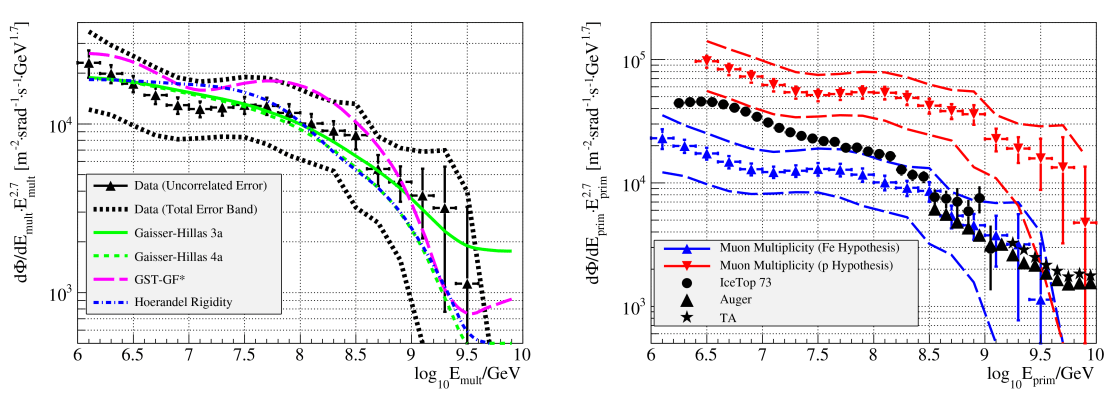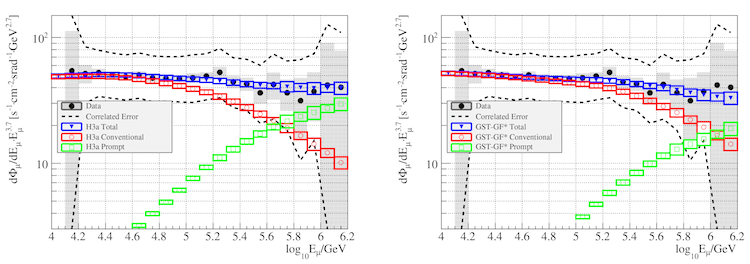Detecting an abundance of the same type of particle in physics can be an annoying background, an opportunity to learn something new, or both. This is the case for atmospheric muons in IceCube, where over 250 million are detected in the Antarctic detector every day, hiding the highly sought-after astrophysical neutrinos, but also enabling in-depth studies of cosmic rays.
In a new study presented a few days ago, the IceCube Collaboration reports the potential of atmospheric muons detected in IceCube to help our understanding of important properties of cosmic rays in a wide range of energies. These muons are also shown to be useful for investigating systematic uncertainties in neutrino studies in IceCube. Measurements of the composition of primary cosmic rays, the high-energy spectrum of muons, and the prompt flux are three of the highlights of this paper, which was submitted last Friday to Astroparticle Physics.

The measurement of the primary composition of high-energy cosmic rays, especially above the “knee,” where the contribution of extragalactic cosmic rays is expected to become noticeable, is one of the current challenges for cosmic-ray experiments. The flux of high-energy cosmic rays is pretty low and requires detectors of at least a square kilometer in size to catch the secondary particles generated by those cosmic rays when they interact with the Earth’s atmosphere. Indirect measurements, using secondary particles in the atmospheric air showers, allow better precision over a broader range of energies.
These indirect measurements are sensitive not only to the spectrum and composition of primary cosmic rays but also to the properties of the particle interactions in the extended air shower. In the region around the knee and above, direct hadronic interaction measurements from accelerators are still limited. Thus, scientists use extrapolations of the properties known from measurements at lower energies, which can then be tested comparing the expected predictions for different interaction models.
Atmospheric muons in IceCube are potentially a great tool for these studies, due both to the large collection area of the Antarctic detector and the possibility of tracking particles over a long distance. And from the results now presented by the collaboration, these muons certainly have plenty to tell us.
Researchers have investigated the composition of primary cosmic rays over more than three orders of magnitude in energy using only the buried component of IceCube, i.e., without the surface component—called IceTop—that was designed for cosmic-ray studies. “The region above 3×1017 is especially interesting, since it’s not well covered by other experiments,” explains Patrick Berghaus, an IceCube researcher at DESY and corresponding author of this paper. “In the future, we will be able to go even further and investigate the composition of extragalactic cosmic rays,” adds Berghaus.

The study also presents a measurement of the all-sky muon energy spectrum at energies between 1013 and 1015 eV, covering the “knee” region. The results show a smooth shape that suggests a substantial contribution from prompt muons, i.e., muons coming from decays of charm mesons. This shows IceCube to be a suitable detector for investigating interesting cosmic-ray physics around this region as well as for making particle physics measurements such as the contribution of the prompt flux.
In fact, IceCube researchers have also performed a measurement of the muon prompt flux, which is not yet conclusive but that excludes the null hypothesis at more than 3 sigma. The prompt component has not been observed so far, neither with muons nor with neutrinos. These new results set up strong constraints on the muon prompt flux, which is the largest uncertainty in the background estimation of astrophysical neutrinos searches.
This study was based on only one year of IceCube data, but measurements are already limited by unidentified detector uncertainties. Major improvements can be expected with new data samples and a better understanding of systematic effects.
+ Info “Characterization of the Atmospheric Muon Flux in IceCube,” IceCube Collaboration: M.G. Aartsen et al. Astroparticle Physics 78 (2016), www.sciencedirect.com arxiv.org/abs/1506.07981